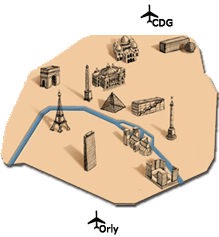
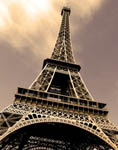
The "Grande Dame Parisienne " was built for the Universal Exhibition of 1889, to commemorate the centenary of the Revolution. The Tour is high about 350 meters! Admission (elevator to 2nd floor): EUR 9 for adults, EUR 5.30 for children under 12. Hours: Jan 1-June 13: 9h30-23h00 every day. (for sports, access stairs is open from 9:30 to 18:00); June 14 - Aug. 31: 9:00 am to midnight every day
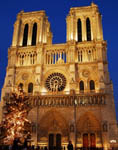
The construction work began in the year 1163, and was completed 200 years later, around 1345. The cathedral can accommodate over 6,000 worshipers. Admission is free, but if you want to climb the towers, will pay about EUR 6. The architects had not anticipated elevator, a heart condition should not take the path of heaven ... Hours: 8h00-18h45 every day. Guided tours: 9h30-18h45 every day. Masses: 8:00, 9:00, noon, 18.45
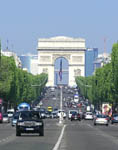
Only the Champs Elysees from the Place de la Concorde at the Grand Palais deserves the title of "most beautiful avenue in the world." The rest of the avenue is lined with shops and restaurants too expensive. Try the side streets. Do not forget to visit the Arc de Triomphe at the top of the avenue, built in the mid-eighteenth century to commemorate Napoleon's victories. Admission is about EUR 6, free for children under 12. Hours: 9:30 to 23:00 daily from April to October, and 10:00 to 23:00 every day from November to March.
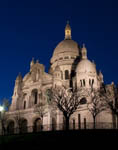
From Romano-Byzantine basilica crowns the Montmartre hill. Begun in 1875, its construction was completed in 1914. Admission is free, but access to the crypt and dome is paid (about EUR 5). To save you a little tired, you can take the funicular, funny little at a tram car. From the subway station Antwerp, start up the hill to rue Tardieu. The funicular station is located there. Until the nineteenth century, Montmartre was a village outside the walls of Paris. The film Amélie Poulain gives you an overview of the place, he must visit, if only because it contains no less than 7 museums!
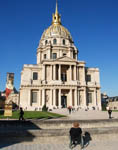
The hospice Invalides building started in 1671 by order of Louis XIV, who wanted to house the soldiers and seriously wounded his many wars. The book was quickly ended, but he was then a church assistant. The work took a total of thirty years. You can visit the church, several museums and the tomb of Napoleon 1st, whose body was repatriated from St. Helena in 1830. Admission is 6 euros, and free for children under 12. Hours: October to March 31, from 10:00 to 16:45 from April to 30 September from 10.00 to 17.45.
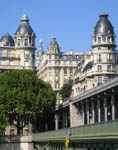
This district, whose history is closely linked to the cultural and artistic life of our capital, is bounded on the north by the dock Malaquais and south by the rue du Four. To the west, the streets of the Holy Father is on the border with the seventh arrondissement and rue de Seine is at the crossroads of areas of the Currency and the Odeon. This area is a strategic place of cultural life in Paris where artists' studios, libraries and museums are numerous, and a place in fashion where it is good to be seen.
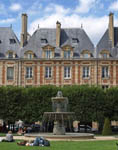
It is Henri IV started the construction of the famous square, which was completed in 1612, two years after the assassination of Ravaillac by Gascon. Initially named 'Royal Square', it was renamed 'Place des Vosges' by Napoleon 1st, who is wanted by paying tribute to the inhabitants of the Vosges to promptly pay their taxes. The square is remarkable both by its style (it is lined with 36 buildings dating from its construction) and by its shops and its small park in the center of which stands the statue of Louis XIII